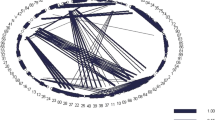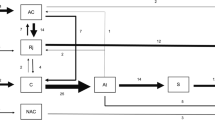Abstract
We describe the details of the mating behavior of the Japanese badger, Meles anakuma, using camera trapping. Similar to other mustelid species, the females copulated with multiple males (mean = 3.0). Repeated mounting with the same male was observed, occurring 3.4 times on average. The average duration of the mounting bout was approximately 70 min, which was much longer than that observed for the congener M. meles. Following the initial mounting bout, males constructed a rest site by gathering fallen leaves and branches close to the female sett. Males rested at these sites between mounting bouts, likely to guard their mates from rival males. The mating pairs displayed a preference for returning to the same location for copulatory activities, which resulted in the dispersal of fallen leaves and surface soil disturbance. We found that some males restored the copulation site by covering it with leaves, soil, and branches after all mating behaviors were completed. This action prevented rival males from locating females, especially if they relied on olfactory cues from the copulation sites. Our study reveals interspecific differences in mating behavior within Meles and the relationship between social systems and mating behavior. Digital video images related to this article are available at http://www.momo-p.com/showdetail-e.php?movieid=momo240213ma01a, http://www.momo-p.com/showdetail-e.php?movieid=momo240213ma02a, http://www.momo-p.com/showdetail-e.php?movieid=momo240213ma04a, http://www.momo-p.com/showdetail-e.php?movieid=momo240213ma05a, and http://www.momo-p.com/showdetail-e.php?movieid=momo240213ma06a.





Similar content being viewed by others
Data availability
Nothing applicable.
References
Allen ML, Wittmer HU, Wilmers CC (2014) Puma communication behaviours: understanding functional use and variation among sex and age classes. Behaviour 151:819–840
Allen ML, Gunther MS, Wilmers CC (2017) The scent of your enemy is my friend? The acquisition of large carnivore scent by a smaller carnivore. J Ethol 35:13–19
Chamura S (1983) Observations on behavior of Japanese badgers. Asa Zoo Breed Rec Collect 12:28–33 (in Japanese)
Charlton BD, Newman C, Macdonald DW, Buesching CD (2020) Male European badger churrs: insights into call function and motivational basis. Mamm Biol 100:429–438
Christian SF (1995) Observations of extra-group mating and mate-defence behaviour in badgers, Meles meles. J Zool 237:668–670
Clutton-Brock TH, Isvaran K (2006) Paternity loss in contrasting mammalian societies. Biol Lett 2:513–516
Dugdale HL, Macdonald DW, Pope LC, Burke T (2007) Polygynandy, extra-group paternity and multiple-paternity litters in European badger (Meles meles) social groups. Mol Ecol 16:5294–5306
Dugdale HL, Griffiths A, Macdonald DW (2011) Polygynandrous and repeated mounting behaviour in European badgers, Meles meles. Anim Behav 82:1287–1297
Eppley TM, Ganzhorn JU, Donati G (2016) Latrine behaviour as a multimodal communicatory signal station in wild lemurs: the case of Hapalemur meridionalis. Anim Behav 111:57–67
Girard-Buttoz C, Heistermann M, Rahmi E, Agil M, Fauzan PA, Engelhardt A (2014) Costs of mate-guarding in wild male long-tailed macaques (Macaca fascicularis): physiological stress and aggression. Horm Behav 66:637–648
Grant J, Hawley A (1991) Some observations on the mating behaviour of captive American pine martens Martes americana. Act Theol 41:439–442
Hedmark E, Persson J, Segerström P, Landa A, Ellegren H (2007) Paternity and mating system in wolverines Gulo gulo. Wildl Biol 13:13–30
Holland OJ, Gleeson DM (2005) Genetic characterisation of blastocysts and the identification of an instance of multiple paternity in the stoat (Mustela erminea). Conserv Genet 6:855–858
Hoogland JL (2013) Why do female prairie dogs copulate with more than one male? Insights from long-term research. J Mammal 94:731–744
Jennions MD, Petrie M (2000) Why do females mate multiply? A review of the genetic benefits. Biol Rev 75:21–64
Jordan NR, Mwanguhya F, Furrer RD, Kyabulima S, Rüedi P, Cant MA (2011) Scent marking in wild banded mongooses: 2. Intrasexual overmarking and competition between males. Anim Behav 81:43–50
Kaneko Y (2015) Meles anakuma Temminck. In: Ohdachi SD, Ishibashi Y, Iwasa MA, Fukui D, Saitoh T (eds) The wild mammals of Japan, vol 1842, 2nd edn. Shoukadoh Book Sellers, Kyoto, pp 266–268
Kaneko Y, Kanda E, Tashima S, Masuda R, Newman C, Macdonald DW (2014) The socio-spatial dynamics of the Japanese badger (Meles anakuma). J Mammal 95:290–300
Kvarnemo C, Simmons LW (2013) Polyandry as a mediator of sexual selection before and after mating. Philos Trans R Soc Lond B Biol Sci 368:20120042
Lode T (1995) Activity pattern of polecats Mustela putorius L. in relation to food habits and prey activity. Ethology 100:295–308
Macdonald DW, Harrington LA, Newman C (2017) Dramatis personae: an introduction to the wild musteloid. In: Macdonald DW, Newman C, Harrington LA (eds) Biology and conservation of musteloids. Oxford University Press, Oxford, pp 3–74
Qi XG, Grueter CC, Fang G, Huang PZ, Zhang J, Duan YM, Huang ZP, Garber PA, Li BG (2020) Multilevel societies facilitate infanticide avoidance through increased extrapair matings. Anim Behav 161:127–137
Ramm SA, Edward DA, Claydon AJ, Hammond DE, Brownridge P, Hurst JL, Beynon RJ, Stockley P (2015) Sperm competition risk drives plasticity in seminal fluid composition. BMC Biol 13:1–18
Raveh S, Heg D, Viblanc VA, Coltman DW, Gorrell JC, Dobson FS, Balmer A, Neuhaus P (2011) Male reproductive tactics to increase paternity in the polygynandrous Columbian ground squirrel (Urocitellus columbianus). Behav Ecol Sociobiol 65:695–706
Roper TJ (2010) Badger. Harper Collins Publishers, London
Ross J, Hearn AJ, Macdonald DW (2017) Musteloid sociality: the grass-roots of society. In: Macdonald DW, Newman C, Lauren A, Harrington LA (eds) Biology and conservation of musteloids. Oxford University Press, Oxford, pp 167–188
Schneider MR, Mangels R, Dean MD (2016) The molecular basis and reproductive function(s) of copulatory plugs. Mol Reprod Dev 83:755–767
Tanaka H (2005) Seasonal and daily activity patterns of Japanese badgers (Meles meles anakuma) in Western Honshu, Japan. Mamm Study 30:11–17
Tanaka H (2006) Winter hibernation and body temperature fluctuation in the Japanese badger, Meles meles anakuma. Zool Sci 23:991–997
Tanaka H (2015) Japanese badger Meles anakuma. In: Seki Y, Enari H, Kodera Y, Tuji Y (eds) Field research methods for wildlife management. Kyoto University Press, Kyoto, pp 123–145 (in Japanese)
Tanaka H, Yamanaka A, Endo K (2002) Spatial distribution and sett use by the Japanese badger, Meles meles anakuma. Mamm Study 27:15–22
Tanaka H, Fukuda Y, Yuki E, Ota Y, Hosoi E, Kojima W (2022) Cooperative den maintenance between male Japanese badgers that are delayed dispersers and their mothers. J Ethol 40:3–11
Tatara M (1994) Notes on the breeding ecology and behavior of Japanese martens on Tushima Islands, Japan. J Mamm Soc Jpn 18:67–74
Thom MD, Macdonald DW, Mason GJ, Pedersen V, Johnson PJ (2004) Female American mink, Mustela vison, mate multiply in a free-choice environment. Anim Behav 67:975–984
Wolff JO, Macdonald DW (2004) Promiscuous females protect their offspring. Trends Ecol Evol 19:127–134
Woodroffe R, Macdonald DW (1992) Badger clans: demographic groups in an antisocial species. J Zool 227:696–698
Yamaguchi N, Sarno RJ, Johnson WE, O’Brien SJ, Macdonald DW (2004) Multiple paternity and reproductive tactics of free-ranging American minks Mustela vison. J Mammal 85:432–439
Yamaguchi N, Dugdale HL, Macdonald DW (2006) Female receptivity, embryonic diapause, and superfetation in the European badger (Meles meles) implications for the reproductive tactics of males and females. Q Rev Biol 81:33–48
Zamudio KR, Sinervo B (2000) Polygyny, mate-guarding, and posthumous fertilization as alternative male mating strategies. Proc Natl Acad Sci U S A 97:14427–14432
Zschille J, Stier N, Roth M (2010) Gender differences in activity patterns of American mink Neovison vison in Germany. Eur J Wildl Res 56:187–194
Acknowledgements
The authors would like to thank the chief priests of Shunryuji, Jinfukuji, Myoukiji, Houmyouin, and Zuiyouji for their permission to perform the fieldwork and for providing information.
Funding
This study was partially financed by a grant from the Yamaguchi Prefecture Environmental Conservation Activities.
Author information
Authors and Affiliations
Contributions
HT designed the study. HT, YF, and EY collected the data. HT and WK analyzed the data. HT and WK prepared the manuscript.
Corresponding author
Ethics declarations
Conflict of interest
The authors declare that they have no conflicts of interest.
Ethical approval
All applicable international, national, and institutional guidelines for animal care and use were followed. This article does not contain any studies with human participants performed by any of the authors.
Additional information
Publisher's Note
Springer Nature remains neutral with regard to jurisdictional claims in published maps and institutional affiliations.
Supplementary Information
Below is the link to the electronic supplementary material.
Supplementary file3 Video 1. Refusal behavior of female Japanese badgers (Meles anakuma) before mounting. A male badger produced “churring” mating calls, though the male was outside view of the camera. A female emerged from the sett in response to the mating calls and chased him while barking. The male ran away. (46.7 MB, 00:00:27). Shot Date: 2018/3/23. Shot Location: Yamaguchi City, Yamaguchi, Japan. Other information: Use of Canon camera system with video light. Species: Meles anakuma. Key Words: Refusal behavior, Mating call, Scent-marking, Chasing (MOV 46708 KB)
Supplementary file4 Video 2. Mating behavior of the Japanese badger Meles anakuma. A male entered a sett by producing mating calls. Subsequently, he bit the female and let her leave. He subsequently held her between his paws in a mounting posture and copulated with her. (10.7 MB, 00:00:50). Shot Date: 2017/3/1. Shot Location: Yamaguchi City, Yamaguchi, Japan. Other information: Use of Canon camera system with video light. Species: Meles anakuma. Key Words: Copulation, Mounting, Mating call, Scent-marking (MOV 10667 KB)
Supplementary file5 Video 3. Mating behavior of the Japanese badger Meles anakuma. Males were closer to female setts. The female emerged from her sett and lowered her head. The male immediately bit the neck. He subsequently held her between his paws in a mounting posture and copulated with her. (39.7 MB, 00:00:32). Shot Date: 2017/3/4. Shot Location: Yamaguchi City, Yamaguchi, Japan. Species: Meles anakuma. Key Words: Copulation, Mounting, Mating call, Scent-marking (MOV 39673 KB)
Supplementary file6 Video 4. Time-lapse images of concealing behavior at a mating site by a male Japanese badger (Meles anakuma) after copulation. A male copulated with a female from 13:18 to 15:06 when he pressed the female against the ground. The male completed copulation at 15:07. At the time, the ground at the mating site was bare. The male had completely covered evidence of mating (i.e., bare ground) with fallen leaves and soil at 15:12. (14.2 MB, 00:00:23). Shot Date: 2015/4/16. Shot Location: Chino City, Nagano, Japan. Other information: Use of flashlight. Species: Meles anakuma. Key Words: Concealing behavior, Mating site (MOV 14167 KB)
Supplementary file7 Video 5. An intruding male slowly approached the mating pair and attacked the mounting male, thereby interrupting copulation. The intruder ran away, and the female headed for the sett. (24.9 MB, 00:00:24). Shot Date: 2018/3/15. Shot Location: Yamaguchi City, Yamaguchi, Japan. Other information: Use of an infrared video camera. Species: Meles anakuma. Keywords: Interrupting copulation, Intruding male, Mating site, Mounting male (MOV 25529 KB)
About this article
Cite this article
Tanaka, H., Fukuda, Y., Yuki, E. et al. Mating behavior in the Japanese badger Meles anakuma. J Ethol 42, 89–96 (2024). https://doi.org/10.1007/s10164-024-00810-y
Received:
Accepted:
Published:
Issue Date:
DOI: https://doi.org/10.1007/s10164-024-00810-y




